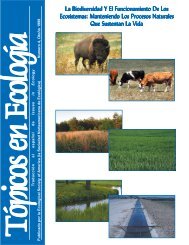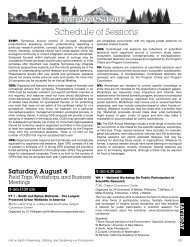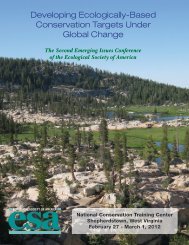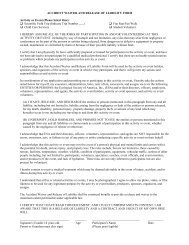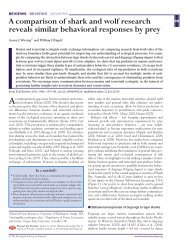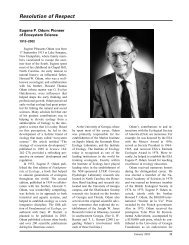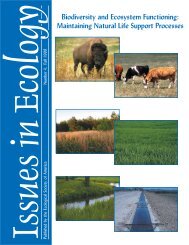Printed Program (PDF) - Ecological Society of America
Printed Program (PDF) - Ecological Society of America
Printed Program (PDF) - Ecological Society of America
You also want an ePaper? Increase the reach of your titles
YUMPU automatically turns print PDFs into web optimized ePapers that Google loves.
10:50 AM OOS 54-9 Zarnetske, PL 1 , MC Urban 2 and DK Skelly 1 ,<br />
(1)Yale University, (2)University <strong>of</strong> Connecticut. Climate<br />
change effects on community composition and species<br />
distributions: The relative influence <strong>of</strong> species interactions.<br />
11:10 AM OOS 54-10 Erfmeier, A, S Klein, E Welk and H Bruelheide,<br />
Martin Luther University Halle-Wittenberg. The role<br />
<strong>of</strong> climatic niche shifts and study type for phenotypic<br />
differentiation – A meta-analysis on native and invasive<br />
plant performances in common environment studies.<br />
COS 172 - Abundance And Rarity<br />
A103, Oregon Convention Center<br />
8 am-11:30 am<br />
OOS 55 - Effect Sizes <strong>of</strong> Global Change Impacts<br />
Across Spatiotemporal Scales and Organizational<br />
Levels<br />
A106, Oregon Convention Center<br />
Organized by: ES Gornish (egornish@bio.fsu.edu), S Leuzinger<br />
Moderator: S Leuzinger<br />
Many global change studies have demonstrated changes in effect<br />
size or even a sign reversal as experiments continue over many years,<br />
or span multiple levels <strong>of</strong> organization. This symposium <strong>of</strong>fers broad<br />
perspectives on global change research, dealing with effect sizes<br />
across ecosystems, temporal and spatial scales, and organizational<br />
levels.<br />
8:00 AM OOS 55-1 Bachelet, DM, D Conklin and K Ferschweiler,<br />
Conservation Biology Institute. Simulating climate<br />
change effects at various scales: can usable guidance<br />
emerge from an ensemble <strong>of</strong> outcomes?.<br />
8:20 AM OOS 55-2 Buckley, LB and JG Kingsolver, University <strong>of</strong><br />
North Carolina at Chapel Hill. Impacts <strong>of</strong> shifts in climate<br />
means and extremes on alpine butterfly demography.<br />
8:40 AM OOS 55-3 Ibanez, I<br />
Life on Earth: Preserving, Utilizing, and Sustaining our Ecosystems<br />
173<br />
1 , JM Diez1 , CJB Sorte2 , D Blumenthal3 ,<br />
LP Miller2 , N Molinari4 , ED Grosholz5 , CM DAntonio4 ,<br />
SJ Jones6 and J Olden7 , (1)University <strong>of</strong> Michigan, (2)<br />
University <strong>of</strong> Massachusetts - Boston, (3)USDA-ARS, (4)<br />
University <strong>of</strong> California Santa Barbara, (5)UC Davis, (6)<br />
University <strong>of</strong> South Carolina, (7)University <strong>of</strong> Washington.<br />
Will invasive species outperform native competitors under<br />
9:00 AM<br />
9:20 AM<br />
global change? Using effect size to assess invasive and<br />
native species sensitivity to future conditions.<br />
OOS 55-4 Gornish, ES, Florida State University.<br />
Interactive effects <strong>of</strong> global change and invasion on<br />
biotic response across organizational levels in an oldfield<br />
plant community.<br />
OOS 55-5 Hellmann, JJ1 , KR Hall2 and NV Chawla1 9:40 AM<br />
, (1)<br />
University <strong>of</strong> Notre Dame, (2)The Nature Conservancy.<br />
Online collaboration to enable research and planning in<br />
climate change biology and adaptation science.<br />
Break<br />
9:50 AM OOS 55-6 Niu, S, R Sherry, X Zhou and Y Luo, University<br />
<strong>of</strong> Oklahoma. Ecosystem water fluxes in response to<br />
climate warming and bi<strong>of</strong>uel harvest in a tallgrass prairie.<br />
10:10 AM OOS 55-7 Levy, O1 , LB Buckley2 , TH Keitt3 and MJ<br />
Angilletta1 , (1)Arizona State University, (2)University <strong>of</strong><br />
North Carolina at Chapel Hill, (3)The University <strong>of</strong> Texas<br />
at Austin. The costs <strong>of</strong> uncertainty: How the resolution <strong>of</strong><br />
environmental data affect the predictions <strong>of</strong> mechanistic<br />
models.<br />
10:30 AM OOS 55-8 Schymanski, SJ, ETH Zurich. Elevated<br />
CO2 , vegetation and the hydrologic cycle – the role <strong>of</strong><br />
observations and models.<br />
10:50 AM OOS 55-9 Conlisk, EE1 , AD Syphard2 , J Franklin3 , L<br />
Flint4 , A Flint4 and HM Regan5 8:00 AM COS 172-1 Oswalt, CM<br />
, (1)University <strong>of</strong> California,<br />
Riverside, (2)Conservation Biology Institute, (3)Arizona<br />
State University, (4)USGS California Water Science<br />
Center, (5)University <strong>of</strong> California. A sensitivity analysis<br />
<strong>of</strong> spatially dynamic population models <strong>of</strong> global change.<br />
1 and HW Brooks2 , (1)USDA<br />
Forest Service - Southern Research Station, (2)USDA<br />
Forest Service. The shrinking footprint <strong>of</strong> longleaf pine<br />
(Pinus palustris) in the southeastern United States.<br />
8:20 AM COS 172-2 Southworth, D and JL Frank, Southern<br />
Oregon University. Rarity in sequestrate fungi (truffles): A<br />
function <strong>of</strong> niche width or productivity.<br />
8:40 AM COS 172-3 Reusser, D1 , H Lee II2 and E Saarinen3 ,<br />
(1)USGS, (2)U.S. Environmental Protection Agency,<br />
(3)University <strong>of</strong> Michigan-Dearborn. Hierarchical<br />
frameworks for distributional and life history data:<br />
Implementation <strong>of</strong> a new ecoinformatics tool.<br />
9:00 AM COS 172-4 Paul, JR and AL Angert, Colorado State<br />
University. The historical demography <strong>of</strong> geographic<br />
range limits.<br />
9:20 AM COS 172-5 Cobbold, C and T Leinster, University <strong>of</strong><br />
Glasgow. Measuring biodiversity: The importance <strong>of</strong><br />
species similarity.<br />
9:40 AM<br />
9:50 AM<br />
Break<br />
COS 172-6 Kroiss, SJ and TM Knight, Washington<br />
University in St. Louis. Dispersal limits rare species<br />
establishment in restored habitats more than competition<br />
or stress.<br />
10:10 AM COS 172-7 Yenni, GM, Utah State University. Strong selflimitation<br />
for rare species across environments and taxa.<br />
10:30 AM COS 172-8 Neel, MC1 and JP Che-Castaldo2 , (1)<br />
University <strong>of</strong> Maryland, (2)University <strong>of</strong> Maryland,<br />
College Park. Predicting endangered species recovery<br />
objectives using biological traits and patterns <strong>of</strong> decline.<br />
10:50 AM COS 172-9 Kulmatiski, A, KH Beard and J Heavilin, Utah<br />
State University. Plant-soil feedbacks provide an additional<br />
explanation for diversity-productivity relationships.<br />
COS 173 - Aquatic Ecology: Lakes And Ponds<br />
B112, Oregon Convention Center<br />
8:00 AM COS 173-1 Twining, CW1 , DM Post1 , DC West1 and<br />
CE Geiss2 , (1)Yale University, (2)Trinity College. Past<br />
ecosystem dynamics in Connecticut’s coastal freshwaters:<br />
Linking paleoecology and nutrient loading models.<br />
8:20 AM COS 173-2 Parsons, M1 , MC Thoms1 and J Flotemersch2 ,<br />
(1)University <strong>of</strong> New England, (2)U.S. Environmental<br />
Protection Agency. Fundamental concepts for river<br />
management futures.<br />
8:40 AM COS 173-3 Showalter, AM, MJ Vanni and MJ Gonzalez,<br />
Miami University. Diet shifts and developmental<br />
requirements contribute to ontogenetic changes in the<br />
ecological stoichiometry <strong>of</strong> bluegill sunfish (Lepomis<br />
macrochirus).<br />
9:00 AM COS 173-4 McCabe, SK and LA Molot, York University.<br />
Vertical migration by filamentous cyanobacteria<br />
(Aphanizomenon spp.) and the implications for algal<br />
blooms in Lake 227, Experimental Lakes Area, Ontario,<br />
Canada.<br />
9:20 AM COS 173-5 Weeber, RC1 , L Leston2 and N Koper2 , (1)<br />
Environment Canada, (2)University <strong>of</strong> Manitoba. Status<br />
and trends <strong>of</strong> breeding waterbirds in boreal Ontario lakes<br />
(1983-2010).<br />
9:40 AM Break<br />
9:50 AM COS 173-6 Kelly, PT1 , KA Baglini1 , CT Solomon2 , BC<br />
Weidel3 and SE Jones1 , (1)University <strong>of</strong> Notre Dame,<br />
(2)McGill University, (3)US Geological Survey. Does<br />
terrestrial carbon affect zooplankton production? A<br />
survey <strong>of</strong> north temperate lakes.<br />
FRIDAY



